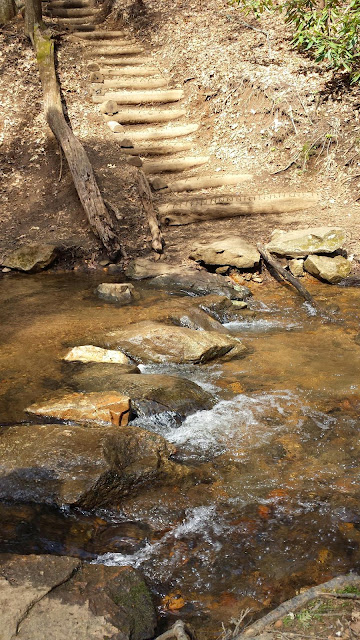I was picked up by my friends Jules and Dennice at the Atlanta airport and we drove to the trail after a great lunch in Dahlonega. We went to weigh my pack and register at the Ranger station at Amicalola first. Pack weighed 27 lbs. Not too bad! I was number 985 in the register. I actually cried when I signed in. Finally fulfilling my dream.
They dropped me off at the parking lot below the summit of Springer. As I was walking up, tears were flowing. All of the Merry Misfits were already there except for Sammie who arrived with Frank right before dark. We all hit it off immediately.
Anna hit the trail earlier than the rest of us and a woman named Heather walked up and asked if I was one of the Misfits. I hate that it was that obvious. She wanted to join our group. No problem!
We finally got going late morning and it took us 2 hours to get down Springer as we were helping Bryan learn the ropes. We only made it to Stover Creek shelter but no problem. We had talked to the ridge runner who told us about a storm coming in around midnight and 100% chance of rain the next day. We decided to experience the shelter so we wouldn't be soaked and have to pack in the rain.
The rain started early and lasted well into the following night. During the next day of hiking in the pouring cold rain our little group got separated. We stopped at Long Creek falls for lunch. We ran into Jenba and Mancub. Cool to see a festie on the trail! We were all hiking different paces after lunch based on our degree of freezingness. We had discussed several options for camping but nothing definite. The others had gotten ahead of me. I ran into Tinker on the road to the Hickory Flats Cemetery. She didn't know where the others were. We decided to go ahead to the next shelter which was about 2 more miles. All we wanted was to be warm and dry. When we got to the shelter at Hawk Mt. Anna (now Meadowlark) was there. The shelter was full but I guess we looked so pathetic, a couple of young men let us have their spots. Small world - my guy used to live on Anna Maria and worked at the Sandbar! Thanks Pig Pen!
Anna was up and gone at the break of dawn. I was ready to go at 10:30 but Tinker wasn't so I left alone. We had a 6 mile stretch that had no water which was very concerning. I took many long breaks hoping someone would catch up. Through the trail grapevine I learned that the group had stayed at the cemetery Pavilion.
At Horse Gap I met some guys and we discussed the water situation. There was no solution but to keep hiking. Sassafras Mt. was next. I had heard of its nickname, Sassafras Kick Your Ass. It lived up to its reputation. About halfway up I was feeling almost panicky about water. I only had about a half liter left with a long way to go. I rounded a corner and there was a nice little trickle coming down the rocks!!! The flow was enough to hold my bottle under. I don't think I'll ever take water for granted again. While I was treating and drinking Tinker showed up. This was REAL trail magic! I was so happy to see her.
We struggled up Sassafras FOREVER and then headed down to Cooper Gap. My left knee was causing me to wince almost every step down. I thought of all the advice I've gotten, some of it opposing like "push through the pain" vs. "don't push too hard". I thought about how many hikers I know who have already gone home with injuries and I didn't want to be the next. I told Tinker that I was going to town the next day or take an on trail zero. But we still had the water problem so we decided to see about town.
We were setting up camp in Cooper Gap and this sweet little lady drove up in a big black Suburban. She was offering snacks. I asked if she knew about shuttles in the area and told her about my knee. She said she'd be back the next morning to pick us up! They call her The Cookie Lady.
She came as promised and gave us the grand tour and history of Dahlonega. We decided on a place to stay and she took us to several places to get things Tinker needed.
As if this trail couldn't get any weirder, she ended up finding Sammie (now Legs) and Jennifer (Milkshake) at the same spot! She offered then a ride a told them about us. They accepted the offer and we are reunited. :)





